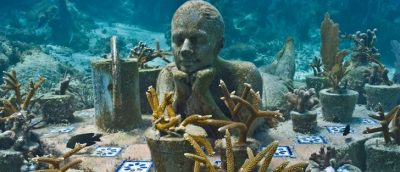 Alanna Mitchell’s new book, ‘Seasick‘ encompasses two and a half years of aquatic research over five continents.
Alanna Mitchell’s new book, ‘Seasick‘ encompasses two and a half years of aquatic research over five continents.
She has literally gone to the oceans depths to see and report upon the hidden ecological crisis of the global ocean. Reading it, a reader becomes profoundly aware of the oceans breadth, width and depth.
Salient facts leap out: a third of the CO2 that we emit goes straight into the ocean, and approximately 80% of the extra heat generated by global warming is being absorbed by the ocean.
“Still, the feeling of vulnerability is a thing alive. We four representatives of our voracious, casually destructive species are here in the belly of the planet’s fundamental life force, at the mercy of a system we are only beginning to understand. We are immersed.
“There’s no way out except back up the way we came. Then we hit bottom: 914.4 metres.
“It’s now 5.9 degrees Celsius.
“The cold is viscous.”
“As in so many other parts of the global ocean, whole, intricate communities of sea life are gone. Great swathes of the food web are no longer there, lost mainly at the top, and neither are key living spaces that once supported them, such as sea-grass beds and salt marshes.”
We are inundated daily with evidence of human impact upon the planetary eco-system. This is the first book I’ve found which looks at our impact upon such a crucial part of it. As with her first book ‘Dancing at the Dead Sea’, Mitchell writes about her personal engagement with the subject and her motivation for the research, and here she explains early on how nearly drowning as a toddler has led to a lifetime of fear around bodies of water.
“Why do we hope? That is still a mystery…we have plausible theories, for example, of how the universe came to be and how the genomic inner workings of a cell operate, how light and time and space function. But we have not parsed the structure of hope, which may be why we long for this remaining mystery to prevail, even as we fear losing faith with it.”
 ‘Seasick’ is her “journey to the deeps”. She spends time around the world with a range of marine scientists; the “planet’s doctors and diagnosticians” all engaged in examining pieces of the problem, be it water quality, pollution, acidity, marine life, or corals, the lungs of the ocean. Mitchell shows us the scientists as deeply engaged, concerned individuals, and I come away motivated to find out more of their particular research and publications.
‘Seasick’ is her “journey to the deeps”. She spends time around the world with a range of marine scientists; the “planet’s doctors and diagnosticians” all engaged in examining pieces of the problem, be it water quality, pollution, acidity, marine life, or corals, the lungs of the ocean. Mitchell shows us the scientists as deeply engaged, concerned individuals, and I come away motivated to find out more of their particular research and publications.
The final chapter ends with Mitchell accompanying Dr. Amy Wright on up close underwater research into extracting chemical compounds from marine creatures that can combat types of cancer. These chemicals lead to the drug Yondelis, which is now approved in Europe for treatment against soft-tissue sarcomas.
The papers by Worms and Meyers (2003-5) on the decline of the worldwide fish populations, and the imminent collapse of all commercial fishing are still resonating in the public discourse, though political action is slow to respond. Mitchell quotes Boris Worm’s gut feeling based on his research on the depletion of fish and marine life: “we now are at the stage of losing the ability of things to come back on their own.” Many who feel the carrying capacity of the world’s resources has already been reached echo this view.
I do feel a sense of despair as I think about all the specifics Mitchell has raised here about the appauling state of the world’s oceans. She examines a ‘dead zone’ or an area of water containing no oxygen in the Gulf of Mexico. This one covers about 17,000 square kilometres, and is just one of 407 worldwide. These blobs represent certain death for fish and any marine life. They are directly caused by climate change, and they directly impact upon us. A recent post on Green Prophet here looks at one man’s efforts to tackle ocean waste.
We know about the ice melting in Antarctica, with its resulting increased sea levels (and the threat this is to coastal areas). How about the high levels of CO2 in the ocean killing symbiotic algae and corroding the reefs? Experts say that changes to the world’s coral reefs are already “locked in”.
Recent media reports talk about saving parts of coral reefs in giant freezers because it may be too late to save them in situ. we covered it in an article here about how Israeli scientists are contributing to this.
There are clear explanations here about the ocean acid-base balance (Ph scale), and the interactions between ocean layers, wind and water, and the ‘chemical transfer’ between air and water.
“Many evolutionary biologists have theorised that humans were able to develop intellectually and travel so far from our African birthplace because we found seafood, with its high fat content – the perfect brain food. This means we can draw a direct line between the sea’s riches and what humans are today. In terms of nutrition and transport – not to mention climate and oxygen – human civilisation and the sea are intimately connected.”
Particularly illuminating was the author’s dissection of human eating habits through the centuries, and how so many factors including the Christian Church throughout Europe, has driven commercial fishing to what it is today. This type of trawling now routinely goes to depths of 500metres, which is double where it was in 1953. Having studied fish farms off the Scottish coast, I have seen first hand the pollution and destruction caused to other sea life. The big fear with this is that escaped farmed fish breed with wild stocks, and very quickly wild fish become eradicated.
Adaptability is the key, and Mitchell goes to Zanzibar to visit a group of women who have developed very small-scale experimental shellfish farms in tidal pools, with the help of Israeli and American marine scientists. There is hope, although Mitchell does point out that on this Island, while fishing and the sea defines this place and its culture, women have always been excluded from this activity. Human dictates and ingenuity frame both the problem and the solution.
Alanna Mitchell is a writer at ease explaining scientific fact and research, and at the same time writing lush evocations of great beauty on her travels around the world, as well as describing fear, insecurity and tragedy. She is a crucial accompanier and witness as humanity tries to wake up and deal with the environmental destruction we have, and are causing to our world.
‘Seasick’ by Alanna Mitchell: Published by www.oneworld-publications.com, UK 2009




here’s an update on the story:
http://www.guardian.co.uk/environment/2012/sep/27/plastic-debris-southern-ocean-pristine
Well, there may be light at the of this “tunnel” if we can use all this extra algae as a bio fuel. But then again, that will only create more CO2, and….
Quick correction: Dead-zones are not caused by climate change, at least not in the normal use of that term. Dead-zones are caused by high levels of nutrients that come from fertilizers running off into water bodies. High nutrient loads lead to high growth of algae, which then use up the oxygen dissolved in the water. It’s this lack of oxygen which prohibits aerobic life in those areas – thus the moniker “dead zones”.